
Hantavirus pulmonary syndrome – Signs, causes, and more
Hantavirus pulmonary syndrome (HPS) is a severe but rare infection that may become life-threatening if you do not take steps to treat it. Its symptoms may be those that resemble the flu, and they may aggravate in no time. People mostly get HPS by inhaling the air infected by droppings, urine, or rodent and mice saliva that has hantavirus. This virus affects the kidneys, lungs, and heart.
The condition has no vaccine or cure, but doctors can give oxygen therapy to manage its symptoms. The earlier it gets diagnosed, the higher the possibility of recovery.
Symptoms
Because of the few hantavirus pulmonary syndrome cases, it is tricky to determine the incubation time. But based on the limited information, the symptoms show between one and eight weeks after exposure to saliva, dropping, and urine of infected rodents.
Early signs include muscle aches in the larger muscle groups like shoulders, back, hips, and thighs, fever, and fatigue. Besides, the infected person may also experience abdominal issues like pain, diarrhea, vomiting, and nausea. Others signs include chills, dizziness, and headaches. Almost fifty percent of all HPS patients experience these signs.
After the initial phase passes, about four to ten days from the onset of the illness, you will experience other symptoms, such as shortness of breath, coughing, and tightness in the chest.
Causes
Every type of hantavirus has a predilection for a particular species of rodent host. For instance, the deer mouse is the typical virus carrier in Central and North America. In America, maximum infections are concentrated in the states West of the Mississippi River. Moreover, in North America, the rice and cotton rats are additional rodent carriers located in the Southeastern region, while the white-footed mouse is the carrier in the Northeastern area.
Transmission
Rodent’s saliva, feces, and urine contains the virus and causes HPS. You may contact the virus in the following ways:
- Consuming food polluted with mouse dropping, urine, or saliva
- Accidentally getting scratched or bitten by an infected rodent
- Inhaling viruses from nesting materials or rodent droppings
- Touching items contaminated with the virus, like a nest, and then touching your eyes, mouth, or nose
The Andes Virus, found in South America, is the only virus strain known to cause person-to-person transmission.
When the virus reaches the lungs, they invade the capillaries, resulting in leakage. Consequently, the lungs get filled with fluid causing more severe heart and lung dysfunction.
Risk factors
In America, HPS cases are prevalent in the rural areas of the West. But contact with rodent habitats can aggravate the susceptibility to catching the disease. The main sites for exposure to rodent droppings, urine, and nests are:
- Farm buildings
- Basements or attics
- Hiking shelters or campsites
- Construction sites
- Seasonal cabins or campers
- Infrequently employed buildings like storage sheds
Beyond this, some activities can also aggravate the susceptibility of exposure to the hantavirus. These comprise:
- Opening and tidying up buildings used in long
- Working in a field that aggravates your contact with rodents, such as pest control, utility work, construction, and farming
- Cleaning the rodent droppings or nests sans apt precautions
Diagnosis
Since most HPS symptoms mimic other viral infections, diagnosis is usually tricky. However, you must consult your doctor when the symptoms worsen and continue longer than anticipated, or you know you have been around mice or rats. They may recommend a blood test to assess the presence of hantavirus and rule out possibilities of other potential problems. Further, doctors may advise other examinations to ensure no similar disease or infection is causing the symptoms.
Treatment
Unfortunately, there is no definitive treatment or cure for HPS. So, if you get hantavirus pulmonary syndrome, doctors may put you in intensive care in the hospital and offer oxygen therapy to help with breathing. It helps clear up the fluid in the lungs. Beyond this, you may also need a breathing tube passing through your mouth or nose. However, in the more severe cases, people may also require blood pumping via a machine that adds oxygen and eliminates carbon dioxide. It is known as extracorporeal membrane oxygenation. Almost sixty percent of people who develop HPS survive. However, treatment generally proves more effective in case of early diagnosis and prompt shifting to intensive care.




